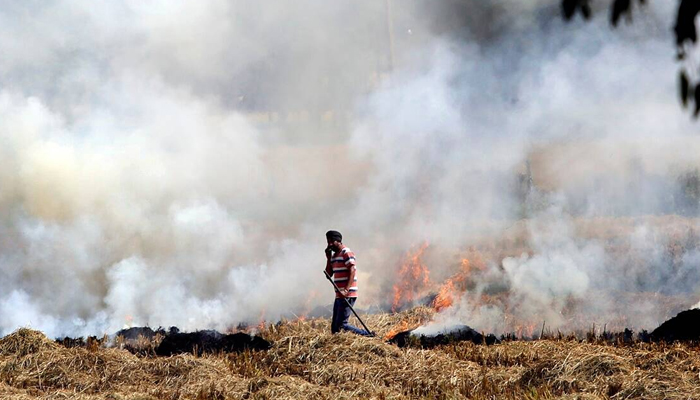By Sahil Sharma: Stubble burning, particularly prevalent in the Indo-Gangetic plains of Punjab, Haryana, and Uttar Pradesh, is a common agricultural practice aimed at clearing paddy crop residues to prepare for the subsequent wheat sowing season. While this method offers a quick solution for farmers facing tight timelines, it poses severe environmental and health challenges, especially in densely populated areas like Delhi and its surrounding regions.
Stubble Burning
As paddy harvesting occurs between the first and last weeks of October, farmers typically have a narrow window of just two to three weeks to clear the fields before sowing wheat from early November to mid-December. In regions employing combined harvesting methods, substantial straw remains after grain collection, leading many farmers to resort to burning as a cost-effective and efficient means of disposal. This practice has gained notoriety for significantly contributing to air pollution, particularly in the autumn months. The burning emits a range of harmful pollutants, including carbon monoxide, methane, and carcinogenic compounds, exacerbating the already poor air quality in northern India.
The Environmental Impact
The consequences of stubble burning extend beyond immediate air quality deterioration. The release of toxic pollutants forms a thick blanket of smog, which not only reduces visibility but also poses serious health risks to the local population. Chronic exposure to these pollutants is linked to respiratory ailments and other health issues. Additionally, burning stubble negatively impacts soil fertility. The high temperatures generated during burning can destroy vital soil nutrients and microbial life, resulting in long-term degradation of soil health. This cycle creates a dependency on chemical fertilizers, further harming agricultural sustainability.
Hotspot Identification and Government Response
Recognizing the urgency of the situation, the Punjab Pollution Control Board (PPCB) has identified eight districts—Sangrur, Ferozepur, Bathinda, Moga, Barnala, Mansa, Tarn Taran, and Faridkot—as stubble-burning hotspots. In 2022, these areas reported over 23,000 incidents of stubble burning, underscoring the scale of the issue. To combat this problem, the PPCB has implemented a detailed action plan and mobilized a workforce of approximately 8,000 officials across various departments. These officials are tasked with monitoring, reporting, and preventing stubble-burning incidents in real-time using a specialized mobile application.
Focus on Innovative Management Strategies
The PPCB aims to manage around 12.7 million tonnes of paddy straw through in-situ techniques, such as mulching and incorporating residue into the soil, while seeking to utilize an additional 5.96 million tonnes through ex-situ measures, which include transporting straw to biomass power plants and other industrial uses. In 2023, Punjab saw a notable decrease in stubble-burning incidents, reflecting the effectiveness of these initiatives.
The Punjab government has also distributed thousands of subsidized crop residue management machines to facilitate these practices among farmers. Encouragingly, a majority of stubble was managed through innovative approaches last year, demonstrating the potential for change.
While stubble burning remains a pressing issue in north India, ongoing efforts by government bodies and increased awareness among farmers offer hope for a more sustainable agricultural future.
